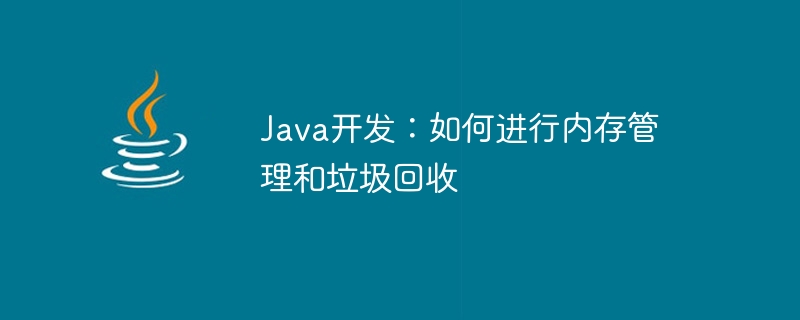Home >Java >javaTutorial >Java development: how to perform memory management and garbage collection
Java development: how to perform memory management and garbage collection
- 王林Original
- 2023-09-20 13:43:41785browse

Java development: How to perform memory management and garbage collection, specific code examples are needed
Introduction:
In Java development, memory management and garbage collection are very important Important topics. Good memory management and garbage collection mechanisms can ensure the performance and stability of application operations. This article will introduce how to perform Java memory management and garbage collection, including memory allocation, memory leaks, garbage collection algorithms, and specific code examples.
1. Memory allocation
In Java, memory allocation is completed automatically, and developers do not need to manually allocate and release memory. When an object is created, the Java Virtual Machine (JVM) automatically allocates memory space and automatically releases the memory space when the object is no longer referenced. This is one of the advantages of Java and one of the reasons why Java is widely used.
2. Memory Leak
Memory leak means that the application cannot release the allocated memory normally, causing the memory usage to continue to increase and eventually causing the application to crash. In Java, memory leaks may be caused by the following reasons:
- Objects are not released correctly: When an object is no longer used, its reference should be manually set to null so that the garbage collection mechanism can correctly Reclaim memory.
- Static reference: Static reference objects will be stored in memory for a long time. Even if they are no longer used, they will not be recycled by the garbage collection mechanism. Therefore, static references need to be used with caution.
- Improper use of collections: When using collection classes, you need to pay attention to promptly deleting elements that are no longer used, otherwise these elements will exist in memory for a long time.
3. Garbage collection algorithm
There are two main Java garbage collection algorithms: mark-clear algorithm and copy algorithm.
- Mark-clear algorithm: This algorithm is divided into two steps. First, all surviving objects are marked, and then unmarked objects are cleared. The advantage of this algorithm is that it does not require additional space, but the disadvantage is that memory fragmentation occurs.
- Copy algorithm: This algorithm divides the memory into two blocks, and only uses one block at a time. When the used memory block is insufficient, copy the surviving object to another free memory block, and then clear the old memory block. This algorithm does not suffer from memory fragmentation, but requires additional space.
4. Code example
- Memory allocation example:
public class MemoryAllocationExample {
public static void main(String[] args) {
String str1 = new String("Hello");
String str2 = new String("World");
System.out.println(str1);
System.out.println(str2);
}
}In this example, we use the constructor of the String object to create When two objects are created, the JVM will automatically allocate memory space to these two objects and automatically release the memory space when no longer in use.
- Memory leak example:
public class MemoryLeakExample {
private static List<Object> list = new ArrayList<>();
public static void main(String[] args) {
for (int i = 0; i < 1000000; i++) {
Object obj = new Object();
list.add(obj);
}
}
}In this example, we use a static List object to save the created Object object. Because Object objects are not deleted from the List at the appropriate time, these objects will exist in memory for a long time, resulting in memory leaks.
Summary:
This article introduces memory management and garbage collection in Java development, including memory allocation, memory leaks, garbage collection algorithms and related code examples. In Java development, good memory management and garbage collection are key to ensuring application performance and stability. By learning and understanding these concepts and techniques, we can better optimize the memory usage of Java applications and reduce the risk of memory leaks.
The above is the detailed content of Java development: how to perform memory management and garbage collection. For more information, please follow other related articles on the PHP Chinese website!
Related articles
See more- Java development practice: springMVC uses AOP to manage access logs
- What is Python's memory management mechanism?
- What is PHP memory management mechanism and garbage collection mechanism? How to understand it?
- Explain JS memory management mechanism and verification
- Chat about php7 garbage collection mechanism

